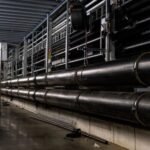Agriculture Technology
Technology is paving new avenues for almost every industry. We are living in an era where we are surrounded by tech solutions. From a simple smartphone to the most recent robot in the market, technology is driving the industrial revolution. And the discussion is not limited to just the tech sector or the financial industry.
Today, areas like farming and agriculture are also driven by the latest tech innovations. Agriculture technology or agritech is the solution that is transforming the farming and horticultural markets. This blog will discuss the impacts of agri-tech, agriculture automation, and the upcoming advancements in the field. Let’s get started.
What is Agriculture Technology?
Agriculture technology, also referred to as Agritech, is a revolutionary addition to the farming sector. It aims to create solutions that enhance agricultural processes and make farming easy, efficient, and sustainable. Agriculture technology is being used among businesses that provide farming products like fertilizers and pesticides to farmers.
It helps agriculture firms to deploy modern technologies like precision farming and automated farming. With the use of AI in agriculture, farmers can increase their agricultural yields, natural resources, and resources, ultimately decreasing waste. Agri-tech is becoming a popular approach and has a significant impact on tackling the challenges that confront agriculture firms today.
Why is it important in Agriculture today?
In the modern world, where everything is under the influence of technology, the agriculture and farming sector is also experiencing a major upgrade. AgTech or Agri-tech has become a crucial aspect of today’s fast world. Its impact on agriculture is necessary as farming contributes to most of the food supply around the world, especially in agricultural nations.
According to the World Bank, it is 4% of worldwide GDP and can go up to 25% in many countries across the globe. Farmers must develop ways to enhance food yields while utilizing fewer resources, such as land, water, and fertilizers, since the world’s population is expected to reach 9.7 billion by 2050. To assist them in this, agricultural technology or Agri-tech plays a vital role.
Let’s understand with the help of an example: Precision agricultural technology (part of agri-tech we’ll talk more about later), like drones and sensors, offers farmers real-time information on soil health, crop development, and insect infestations, allowing them to make well-informed decisions about when and how to apply inputs like water and fertilizer.
Moreover,Agriculture Technology can assist farmers in addressing climate change and other environmental concerns by lowering greenhouse gas emissions and decreasing the usage of hazardous pesticides. Ultimately, AgTech is critical in modern agriculture because it gives new solutions to industry difficulties and ensures that we can continue to produce enough food for a rising population in a sustainable manner.
Evolution of Agri Tech Down the Years
Agri Tech’s growth has been a remarkable journey spanning many decades. Simple mechanisms like the plough and sickle were used in early agricultural technology to help farmers produce and harvest crops more effectively. Irrigation systems and crop rotation strategies were developed over time to boost yields while conserving resources.
Significant advancements in agricultural technology occurred throughout the 20th century, including the introduction of synthetic fertilizers and pesticides, which transformed crop production. Later, when modern-day technologies and computers kicked in, agri-tech experienced the growth of precision agricultural technology, such as sensors, drones, and machine learning algorithms, in recent years. After the 2000s, the evolution of Agri Tech has taken a digital turn.
Agritech 3
Agritech 3.0 traces back to the early 2010s when a group of Silicon Valley entrepreneurs began investigating the possibility of bringing technology to the agriculture business. Kimbal Musk, Elon Musk’s brother, was a prominent participant in this movement, founding The Kitchen Community, an organization committed to constructing school gardens and teaching youngsters about healthy food.
Agritech 3.0, also referred to as precision farming, is the current era of agricultural technology, characterized by the use of modern tech solutions. This Agritech revolution builds on the preceding two phases, which witnessed the creation of early agricultural implements and the growth of precision agriculture technology.
Agritech 4
Agritech 4.0 is the agriculture industry’s buzzword these days, and with good cause. It is also referred to as connected farming. With the term connected, Agritech 4.0 promises to transform the way we grow and produce food by utilizing cutting-edge technology such as AI, machine learning, IoT, and robots. Companies such as John Deere, Monsanto, and DeLaval are leading the way in this industrial revolution, with several fascinating use cases currently in the works.
But, Agritech 4.0 isn’t just for large agribusinesses. Small-scale farmers can also benefit from these technologies since they can help them make better decisions, cut expenses, and boost efficiency. GPS (Global Positioning System) is playing a significant role in the agritech 4.0 revolution, connecting farmers and their fields in a fascinating way across the globe.
Agritech 5
In contrast to Agritech 4.0, which largely focuses on precision agriculture and automation, Agritech 5.0 takes things to a whole new level. Agritech 5.0 or digital farming allows farmers to put enormous amounts of data in use with modern AI-powered crop monitoring and management tools. Meanwhile, automation and vertical farming technology boost efficiency while decreasing environmental effects.
Agritech 5.0 provides an important potential for the agricultural industry to modernize and enhance its operations, making them more sustainable and efficient while simultaneously fulfilling the world’s rising food demand. Agritech 5.0 is all about big data and artificial intelligence, and closely measures practical information to generate possible solutions that can be implemented automatically using robotic farming and other smart agriculture solutions.
The latest Trends in Agri Tech
Mobile Technology in Agriculture
Mobile technology has become an indispensable tool for modern farmers. Smartphones and tablets help farmers to get real-time meteorological data, monitor crop prices, and manage farm activities from anywhere. Farmers use smartphone applications to monitor soil moisture, arrange planting dates, and receive weather alerts early that can damage their crops.
Farmers also use mobile technology to communicate with other farmers, share information, and cooperate on best practices. The extensive use of mobile technology with the latest innovations, such as 5G in agriculture can transform farm management, making farming more efficient and lucrative.
IoT Farming
IoT in agriculture is becoming increasingly popular. With this innovation, farmers can remotely monitor everything from soil moisture levels to crop health. It’s incredible to witness how technology is changing agriculture. Imagine being able to monitor your crops from your phone without having to travel out to the field! IoT sensors enable future farming by allowing farmers to gather real-time data on the state of their fields and make better decisions about when and how to water and fertilize their crops.
This will not only save time and money but also contribute to less water waste and higher crop yields. Furthermore, IoT farming can make farming more environmentally friendly and sustainable by minimizing the need for toxic chemicals and pesticides.
Drone Control and GPS
Drones and GPS technology are transforming how farmers manage their crops. Drones with high-resolution cameras and sensors can take comprehensive pictures of fields, allowing farmers to monitor crop health and detect problem areas. Farmers can utilize GPS technology to accurately manage the placement of their machines and check soil quality, which can increase agricultural yields. GPS and drones also allow farmers to precisely identify agricultural damage caused by pests or weather conditions using the drone GPS technology, and then take action to alleviate the problem.
Let us consider a use case: Drones configured with multispectral sensors may collect photographs of crops in many wavelengths of light, allowing farmers to detect and diagnose plant disease early. This can help to limit the spread of pathogens (diseases) and decrease the need for pesticides, resulting in a healthier crop and higher yields.
Artificial Intelligence Farming
The agriculture business is undergoing a tremendous transition as a result of the rapid growth of technology. One such advancement is the use of Artificial Intelligence in farming techniques. All recent developments, such as IoT devices, drones, and machinery, can be pushed to the next level with AI.
By using artificial intelligence-powered sensors to assist farmers, we can increase efficiency and output while decreasing expenses. AI systems evaluate sensor data to establish ideal planting schedules, monitor crop health, and forecast production.
For Instance, AI-powered sensors can monitor soil moisture levels and automatically adjust the irrigation system in real-time, ensuring that crops get the right quantity of water. This assists farmers in conserving water, lowering expenses, and increasing yields.
Robotic Farming
Robotic farming is the agricultural future, and it is transforming the way we raise food. Robots can now plant, irrigate, and harvest crops with greater precision and efficiency than ever before because of technology and automation. This means farmers can now increase yields, reduce their dependency on physical labor, and use fewer pesticides and other toxic chemicals.
Vertical farm cultivation is an exciting use case for robotic farming through robotics technology. To maximize space and improve growth conditions, these farms use stacked layers of crops cultivated in a controlled environment. Farmers can guarantee that each plant receives the exact quantity of water, nutrients, and light it requires to survive by deploying robots to care for these crops.
Conclusion
To summarize, technology is evolving in the agricultural sector, making it more sustainable, efficient, and profitable. From Artificial Intelligence to drone and GPS technologies to mobile apps, farmers have access to a wide range of tools that can help them make better decisions, increase productivity, and reduce costs. The use of agricultural technology is critical to meeting rising food demand in the face of climate change and environmental issues. As technology advances, we may expect further breakthroughs that will change how we farm.
Stay up-to-date with the latest trends and developments in agriculture technology with Scientific Asia. We upload informative blogs every week.
















